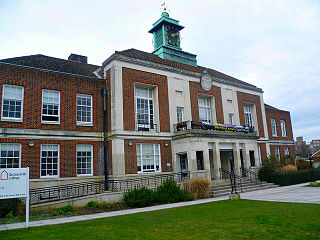Related Research Articles

The Greater London Council (GLC) was the top-tier local government administrative body for Greater London from 1965 to 1986. It replaced the earlier London County Council (LCC) which had covered a much smaller area. The GLC was dissolved in 1986 by the Local Government Act 1985 and its powers were devolved to the London boroughs and other entities. A new administrative body, known as the Greater London Authority (GLA), was established in 2000.

The Metropolitan Borough of Hackney was a metropolitan borough of the County of London from 1900 to 1965. Its area became part of the London Borough of Hackney.
The Camden London Borough Council in London, England is elected every four years. Since the last boundary changes in 2002, 54 councillors have been elected from 18 wards.

Beddington and Wallington was, from 1915 to 1965, a local government district in north east Surrey, England. It formed part of the London suburbs, lying within the Metropolitan Police District and the London Passenger Transport Area. In 1965 it was abolished on the creation of Greater London.

The London Government Act 1899 was an Act of the Parliament of the United Kingdom that reformed the administration of the capital. The Act divided the County of London into 28 metropolitan boroughs, replacing the 41 parish vestries and District Boards of Works administering the area. The legislation also transferred a few powers from the London County Council to the boroughs, and removed a number of boundary anomalies. The first elections to the new boroughs were held on 1 November 1900.

The Municipal Borough of Heywood was, from 1881 to 1974, a local government district in the administrative county of Lancashire, England, with borough status and coterminate with the town of Heywood.

Local government elections were held in the thirty-two London boroughs on Thursday 9 May 1968. Polling stations were open between 8am and 9pm.
The 1964 Southwark Council election took place on 7 May 1964 to elect members of Southwark London Borough Council in London, England. The whole council was up for election and the Labour party gained control of the council.
The 1964 Lambeth Council election took place on 7 May 1964 to elect members of Lambeth London Borough Council in London, England. The whole council was up for election and the Labour party gained control of the council. The election is notable for being the first one ever fought by John Major.
The 1964 Newham London Borough Council election took place on 7 May 1964 to elect members of Newham London Borough Council in London, England. The whole council was up for election and the Labour Party gained control of the council.
The 1964 Lewisham Council election took place on 7 May 1964 to elect members of Lewisham London Borough Council in London, England. The whole council was up for election and the Labour Party gained control of the council.

The 1964 London local elections were held on 7 May 1964. They were the inaugural elections for the thirty-two London boroughs, which were created on 1 April 1965 by the London Government Act 1963. All seats were up for election, with polling stations open between 08:00 and 21:00.
The 1964 Camden Council election took place on 7 May 1964 to elect members of Camden London Borough Council in London, England. The whole council was up for election and the Labour party gained control of the council.
The 1964 Greenwich Council election took place on 7 May 1964 to elect members of Greenwich London Borough Council in London, England. The whole council was up for election and the Labour party gained control of the council.
The 1964 Hackney Council election took place on 7 May 1964 to elect members of Hackney London Borough Council in London, England. The whole council was up for election and the Labour party gained control of the council.
The 1964 Hammersmith Council election took place on 7 May 1964 to elect members of Hammersmith London Borough Council in London, England. The whole council was up for election and the Labour party gained control of the council with almost 63% of the vote.
The 1964 Islington Council election took place on 7 May 1964 to elect members of Islington London Borough Council in London, England. The whole council was up for election and the Labour party gained control of the council.
The 1964 Tower Hamlets Council election took place on 7 May 1964 to elect members of Tower Hamlets London Borough Council in London, England. The whole council was up for election and the Labour party won control.
The 1964 Wandsworth Council election took place on 7 May 1964 to elect members of Wandsworth London Borough Council in England. The whole council was up for election and the Labour party gained control of the council.
The 1964 Westminster Council election took place on 7 May 1964 to elect members of Westminster City Council in London, England. The whole council was up for election and the Conservative party gained control of the council.
References
- ↑ "The Municipal Elections. Final London Results, Names And Figures". The Times . 4 November 1925.
- ↑ Willis, Alan; Woollard, John (2000). Twentieth Century Local Election Results Volume 1: Election Results For the London County Council (1889-1961) and London Metropolitan Boroughs (1900–1928). Plymouth: Local Government Chronicle Elections Centre.
| Preceded by 1922 Southwark Borough election | Southwark local elections | Succeeded by 1928 Southwark Borough election |